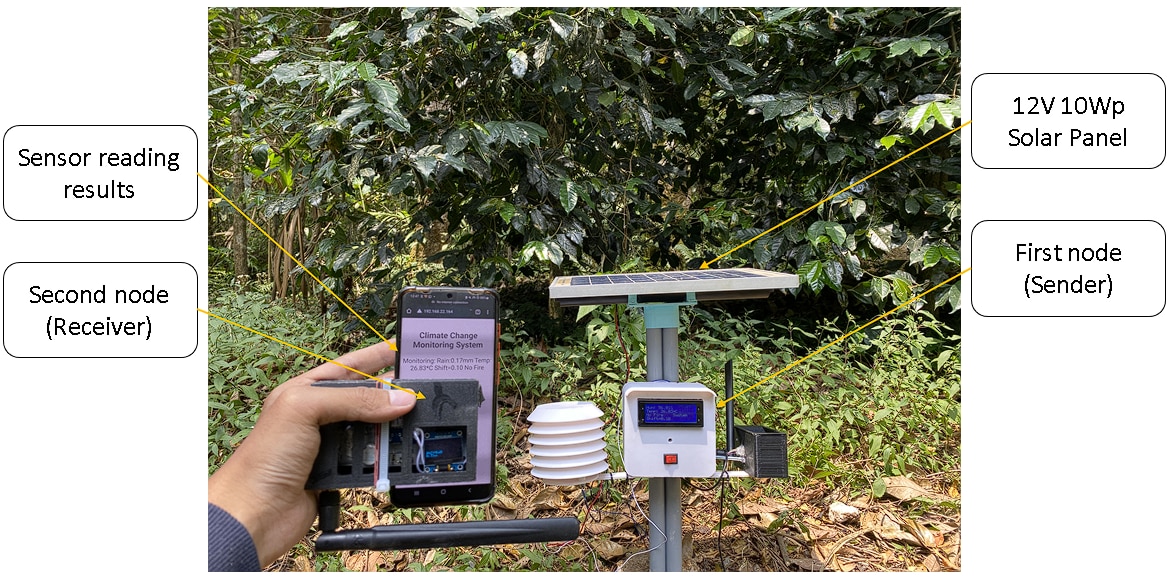After going through a long process, this innovation was successfully created. Hopefully, this tool can significantly benefit many people, especially coffee farmers, to monitor the excellent climate for coffee plants. The following is an overview of the functional test results of the Climate Change Monitoring System.

Based on the results of sensor readings, all sensors used worked well, except for the rainfall sensor, because when testing on the coffee plantation, there was no rain. Here, testing is carried out only for functional purposes, without comparing sensor data with measuring instruments, due to limited time during testing.
The first node receives sensor readings and processes the data using an XIAO SAMD21 microcontroller. The electricity source for the first node comes from a solar panel with a capacity of 12V 10Wp. Next, the processed data is displayed on a 20x4 LCD and sent via the LoRa network with a frequency of 915 MHz.
The second node works by receiving data from the first node via the Lora network, after which the data is displayed on the Oled LCD and sent to the Web Server (Local) to be displayed on the smartphone.
The following is a breakdown of the data when testing functionally:
| Measurement | Results |
| Temperature | 26.83°C |
| Humidity | 56.01% |
| Rainfall | 0.17mm |
| Land Shifting | 0.10g |
| Fire Status | No Fire |
(Temperature And Humidity)
Based on the data above, the temperature and humidity measurements were working well, but an error was found in the rainfall. The possible cause of the error in the reading data was that when the hall effect sensor was installed, it was exposed to a magnet, resulting in an anomaly in the reading data. The following is an overview of the rainfall sensor:
(Rainfall)
Surely, some of you wonder why the solar panel blocks the rainfall sensor. Yes, because I haven't had time to print a longer buffer. I will fix it so there is no functional interference.
The ground shift occurred because I installed the sensor not on a flat ground surface. The ground shift sensor should be placed on a flat surface so that the readings work well because it is difficult to find flat ground. I was forced to install it on the slightly sloping (mountainous) ground, as you can see in the picture below:
(Land Shifting)
Finally, the results of the fire sensor readings work well without being influenced by noise from sunlight. It can be seen in the data in the table above that the sensor did not detect any fire.

(Final Demo)
The conclusions from this innovation are as follows:
- It requires testing over a long period of time to read climate changes and determine a good climate for the productivity of coffee plants.
- This innovation has worked well functionally by testing each sensor.
- Abundant data can help farmers make decisions about when to water coffee plants during the dry season and determine in the following period whether it is worth planting or not.
- With the output in the form of a sprinkler system and the decision whether it is worth planting or not, it is hoped that it can increase the productivity efficiency of coffee farmers.
- Protection against landslides and forest fires is expected to minimize farmers' losses when these disasters occur.
My experience of using the XIAO SAMD21 is that it is a small microcontroller but powerful. It can be proven that when processing decimal numbers from temperature, humidity, and accelerometer sensors, this microcontroller is able to work well. Apart from that, for the sensor that I have tested, namely the DHT20 sensor, the reading accuracy is only difference 1-2 °C, which has very good accuracy.
Finally, I would like to thank element14 and seeed studio, who have allowed me to take part in this competition. Here, I am trying my best to make this innovation. This innovation is far from perfect because there is still a lot that needs to be improved, and it takes a long time to obtain the right test data. Thank You!

